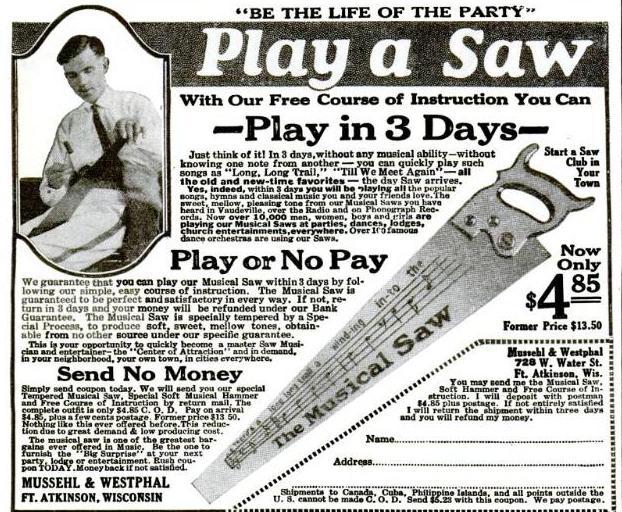
#002 Wild Irish Rose by Mussehl & Westphal (1920)

Image: Mussehl & Westphal Advertisement ca. 1920s
机の上に置いていたものをうっかり落としてしまった. がしゃん.
ほとんどの人はやっちゃったな, なんていう気持ちで, 急いでそれを拾おうとするでしょうけれど, ごくまれに, そのものがたてた音の響きに耳の焦点がぴたりと合ってしまう人もいるようです.
そのようにして発見された楽器に, ミュージカル・ソーというものがあります. 名前の通り, 木材を切る道具であるのこぎりを, 擦ったり叩いたりすることで音を奏でる楽器です. 道具の身近さのせいか, 最初の事例ははっきりしませんが, のこぎりを使う文化のあった世界各地で, 自然発生的に楽器としての使用がはじまったといわれています.
20世紀初頭のアメリカで, 道具としての機能を前提としない, より音楽演奏に適したミュージカル・ソーが開発されます. 改良されたミュージカル・ソーは、ボードウィルや大道芸, サーカスといったショー音楽の演奏家たちに好んで取り入れられたことで, 新奇な楽器としての認知が広がり, 当時の流行品となりました. その一方で, 昔ながらの道具としてののこぎりを使い続ける演奏家もいたといわれます.
日用的な道具がそのままの姿で楽器の世界に溶け込んでいったことは, ミュージカル・ソーの特異性のひとつでしょう. 道具でもあり楽器でもあるという多義的なありかたは, かつてそれを媒介として, 労働と娯楽がなめらかに繋がっていた時代があったことを思い起こさせます. 道具とともに働き, ひと仕事終えれば, その木くずを払って, 慰労のために仲間達と余興を楽しむ. そんな習慣が, ミュージカル・ソーの形態のなかに保持されているようです.
もしかすると, 道具としてののこぎりにこだわった演奏家たちは, 音色以上にそのような文化的な側面に魅力を感じ, ミュージカル・ソーの多義性を繋ぎ止めようとしていたのかもしれません. しかし、第二次世界大戦の勃発による金属価格の高騰で, その流行は終わりを迎え, ミュージカル・ソーの楽器化はそれ以上進行することはありませんでした. 規模は小さくなりましたが, 現在もいくつかの会社によってミュージカル・ソーが生産されています.
「考えてみてください!たった3日間で、音楽の才能がなくても、楽譜が読めなくても、即座に『Long, Long Trail』や『Till We Meet Again』などの有名曲を演奏できるようになります。…ミュージカル・ソーは家庭用、パーティー用、友人を楽しませるのに最適な楽器です。」(Mussehl & Westphal社の古い広告より)
このノートはShukutani Naoshiによって執筆されました。
♦︎♦︎♦︎♦︎♦︎♦︎♦︎♦︎
Something on the table accidentally fell to the floor. Crash.
Most people would rush to pick it up quickly, thinking "Oops, I did it," but occasionally, someone finds their attention unexpectedly captured by the resonating sound it makes.
One such discovery led to the creation of the musical saw. As the name suggests, it is a musical instrument played by rubbing or tapping an ordinary saw—originally a tool for cutting wood. Perhaps due to its familiarity as a tool, the exact origins of the musical saw are unclear, but it is said to have emerged spontaneously in various cultures where saws were commonly used.
In early 20th-century America, musical saws were developed not as tools, but as instruments optimized specifically for musical performance. These refined versions, no longer bound to their original utilitarian function, were quickly embraced by performers in vaudeville, street acts, and circuses. As a result, the instrument gained recognition as a novel curiosity and became a trend of its time. Still, there were players who continued to use traditional carpenter's saws.
That a common household tool could integrate into the world of music almost unchanged is one of the musical saw’s most remarkable qualities. Its dual identity—as both a tool and an instrument—evokes an era when labor and leisure were seamlessly linked. People would work with their tools, brush off the sawdust when the job was done, and entertain themselves with impromptu performances among friends. That custom seems to linger in the very form of the musical saw.
Perhaps the musicians who clung to the traditional saw were captivated not only by its sound but also by the cultural dimension it carried—seeking to preserve its layered identity. However, with the outbreak of World War II and the subsequent rise in metal prices, the musical saw's popularity declined, halting its further development as an instrument. Even so, a number of companies continue to produce musical saws today, albeit on a smaller scale.
“Just think of it! In 3 days, without any musical ability—without knowing one note from another—you can quickly play such songs as “Long, Long Trail” “Till We Meet Again” ...Makes an ideal instrument for the home, parties, entertaining friends.” (from an old Mussehl & Westphal company advertisement)
This note was written by Shukutani Naoshi.
BGM#002
Sound: Wild Irish Rose by Mussehl & Westphal (1920)
Source: https://scruss.com/enterprise.net/musicalsaw.html (Stewart’s Place)
Selector: Shukutani Naoshi
1985年生まれ. クロスシミュレーションを専門にするテクニカルディレクター. 趣味はインターネット.
Born in 1985, a technical director specializing in cloth-simulation. Hobbies include browsing the internet.
〈Now BGM is…〉セレクターの手動ブラウジングによって発見された音源と, それにまつわる断片的な情報のアーカイブ集. インターネットの横道に偶然残ったヘンゼルのパン屑のようなもの.
An archive of audio findings and fragmented notes discovered through selectors' manual browsing. It is like Hansel's breadcrumbs, scattered along the byways of the internet.